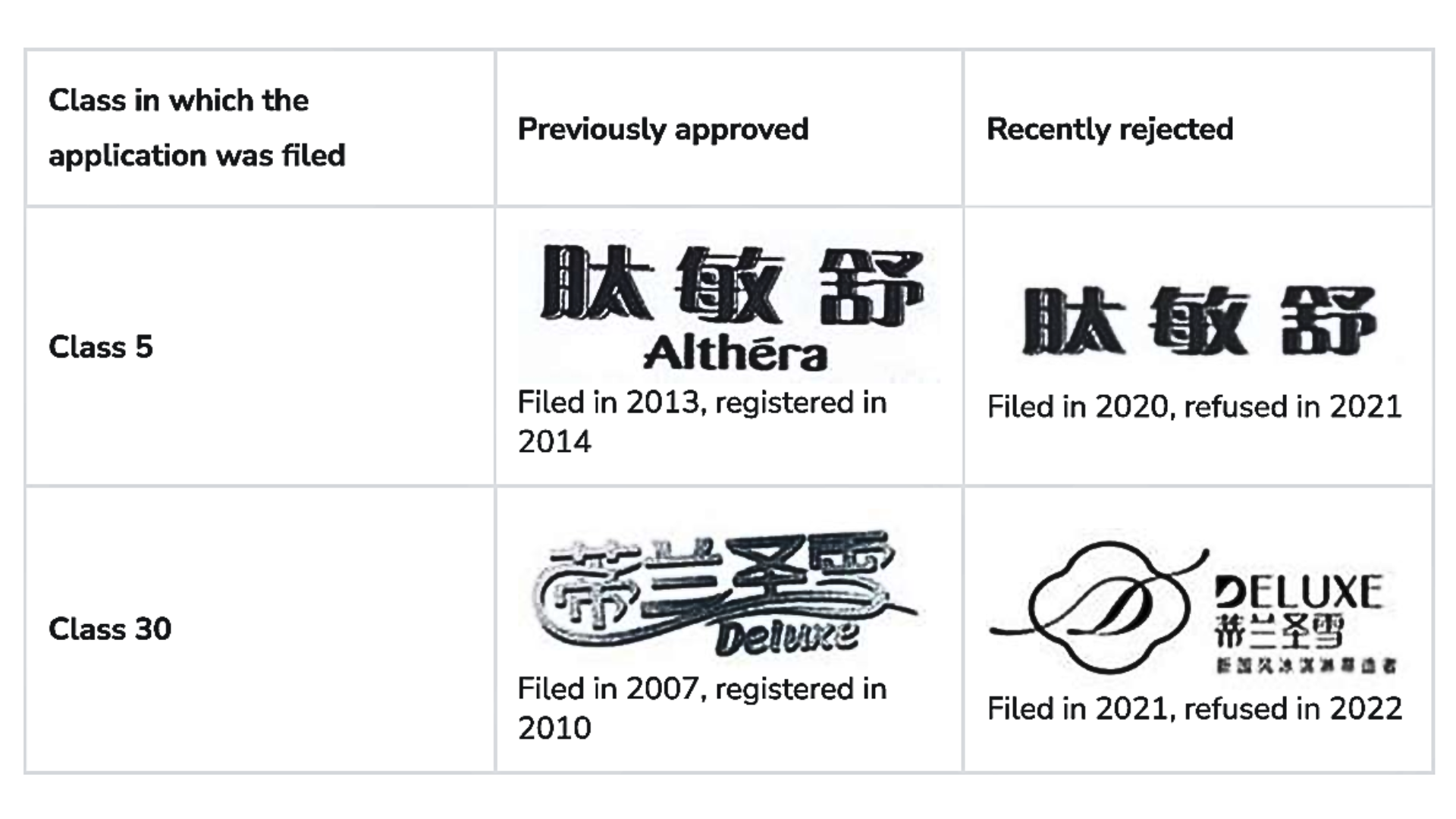Article Originally Published by World Trademark Review. Law Business Research, 25 Jan. 2025.
Amy Hsiao argues that the overuse of Article 10 reasons to reject trademarks risks stifling creativity and innovation in branding, in this week’s opinion column.
Registering a trademark in China has always been an uphill battle. No surprise there – China has been leading the world in trademark applications for decades and is home to more than half of the entire world’s registered trademarks. With such an overwhelming volume of filings, the odds are high that someone has already beaten you to the punch with a similar idea.
But since 2020, a specific ground for trademark rejection has made things even worse, slamming over 20,000 applications in a single year with appeal success rates barely above zero. Yet, for any brand manufacturing, exporting or selling in China, a trademark is not just a nice-to-have- it is a must. So, as we look towards 2025 with rising tariffs and trade tensions, how can businesses navigate this ever-shifting landscape?
Nearly 15,000 trademark refusals based on Article 10.1.7
Article 10.1 refusals cover eight grounds for rejecting trademark applications, but Article 10.1.7 specifically has emerged as the most problematic. Rejections on this ground have skyrocketed by 56%, from 9,254 in 2018 to nearly 15,000 in 2023, according to data supplied by Mozlen.
Meanwhile, appeal success rates have plummeted from 15% in 2020 to 7% in 2024, which is staggeringly low, even by China’s standards. This has made Article 10.1.7 a significant obstacle for businesses attempting to register brands in China.
Number of trademark refusals and successful appeals based on Article 10.1.7 – 2018-2023
While China has tightened its examination standards since the trademark law was last amended in 2019, refusals based on this provision often appear to stem from legal ambiguity rather than clear public interest.
A rejected trademark leaves businesses vulnerable to infringement claims, counterfeiting and bad-faith copycats, lower profits and even the very survival of their brand. With potential tariffs and escalating US-China trade tensions looming in 2025, these challenges are expected to grow, further complicating an already difficult trademark landscape to navigate.
Broad language allows for subjective interpretation
Article 10.1.7 of China’s Trademark Law states that a mark will be refused registration if it is “deceptive, [or] likely to mislead the public about the quality or other characteristics of the underlying goods, or place of origin”.
While the intent of this provision is clear, its broad language has left it open to subjective interpretation – and it has been wielded extensively. As a result, a huge number of trademark applications have been refused under this provision.
Some refusals include justification from the examiner, but many have left applicants and practitioners scratching their heads. The reasons given can be absurd, including examiners cherry-picking obscure dictionary definitions while ignoring the most common meanings or translations. For instance:
- A trademark application that includes DEFENSE does not necessarily imply a connection to National Security or the Department of Defense.
- A pharma-related mark containing GUARD does not automatically suggest a protective medical treatment; it could simply refer to general wellness or preventive care.
- A term like VITAL does not necessarily claim life-saving benefits and is commonly used for health supplements or nutrition products.
Additional examples that highlight the challenges posted by Article 10.1.7 include the following:
- Trademark features partial company name – trademarks featuring abbreviated or commonly known versions of company names can be rejected for being ‘deceptive’. For instance, an application for AB GROUP was refused because the trademark did not include the full legal name (eg, SHAANXI PROVINCE AB GROUP or AB INCORPORATED LIMITED COMPANY GROUP).
- Suggestive trademarks – suggestive marks (which I would argue are fanciful trademarks in the examples provided), which are typically strong trademarks, have fallen victim to Article 10.1.7 if the examiners deem them to be potentially misleading. For instance, a peony logo in Class 5 (baby food) was rejected because the peony is a traditional Chinese herbal ingredient, and the examiner argued that consumers may incorrectly assume that the baby food contained peony. Similarly, the Chinese character mark MU-LI-KANG in Class 5 (contact lens solutions) was refused, because it could be interpreted as promising “immediately healthy eyes”. However, this is just one of many interpretations of the combined Chinese characters. In another case, a trademark application for MAGICIAN in Class 9 (software coverage) was rejected because of the implication of the word. Following this logic, some of the most famous brands (eg, JAGUAR and GREYHOUND) should be rejected because the public could be deceived into believing that the vehicles could run as fast as jaguars and greyhounds!
- Trademark includes industry terms or ingredients – marks that include industry-related terms or references to ingredients have also been flagged. For example, EDEL WEIN in Class 33 (wine, liquor, and sake) was refused because sake and liquor are not technically wein (German for wine). Similarly, MAGNOLIA INFINITA in Class 3 (lotion, soap, and bath salts) was initially rejected because not all the listed goods contained magnolia as an ingredient.
The overzealous use of Article 10 by Chinese authorities represents an overreaction that creates unnecessary hurdles for businesses and stifles commercial progress. This further exacerbates challenges in an already fragile international trade environment.
Inconsistent application leads to interpretation chaos
The challenges are compounded by inconsistencies in how Article 10.1.7 is interpreted by different authorities. A notable example is the trademark, in which each of the four characters refers to a different Chinese herb. The China National Intellectual Property Administration initially refused the application under both Articles 10.1.7 and 11.1.2. However, after an appeal to the Beijing IP Court, the violation was narrowed to Article 11.1.2, under which trademarks that describe raw materials are rejected. The applicant pressed on to the Beijing High Court, which issued a perplexing decision. The mark violated either:
- Article 11.1.2 if the products contained the herbs; or
- Article 10.1.7 if the products did not contain the herbs.
The Supreme Court stepped in, ruling that the mark was descriptive and violated Article 11.1.2, but not Article 10.1.7. Thus, what began as an Article 10 case ultimately ended without an Article 10 issue.
In fact, many marks that were once approved for registration are now facing Article 10 refusals.
Examples of registrations that were previously approved and now rejected:

Continued use of a trademark rejected under Article 10 carries significant legal risks. According to Article 15 of the Standard for Determining General Trademark Violations, penalties can be severe, including fines of up to 20% of the revenue from illegal business activities. But in our experience, this rule is rarely enforced.
Drawing the line between deception and creativity
Trademarks clearly intended to deceive (eg, an alcoholic drink labelled as OOLONG, a chocolate-flavored ice cream called VANILLA SHOW, or a meat restaurant named TREEHOUSE VEGAN) should be flagged. However, deception is a subjective concept, and the law should focus on whether the public is realistically misled, not hypothetical possibilities. Ambiguity in the law is not a good reason to kill creativity and justify rejection.
The concept of deceptive trademarks originates from Article 6-5(2) of the Paris Convention and has been part of China’s Trademark Law since 1983. In 2013, the law added the criterion of “likely to mislead the public about the quality or other characteristics of goods or place of origin”. China’s 2021 Trademark Examination Guideline clarified two key points, namely:
- Deception must involve unreasonable or misleading descriptions likely to confuse the public.
- Determinations should align with the public’s “daily life experience”. If misunderstanding based on the public’s daily life experience is unlikely, this should not be an Article 10.1.7 situation.
The Beijing Court reinforced this in 2015. In a case involving Trademark Application 11051630, the court ruled that Article 10.1.7 violations must meet three conditions, namely:
- The mark must describe the characteristics of the products or services.
- The description must mislead.
- The misleading nature must be sufficient to influence the relevant public’s purchase decisions.
Importantly, deception and confusion are not the same.
Trademarks often use exaggerated or suggestive language for creativity or marketing purposes. This should not automatically trigger rejection under Article 10.1.7, unless the public is genuinely – or likely to be – misled. The trademark office’s role is not to police language or creativity, especially since Article 11 of the Trademark Law already addresses descriptiveness and distinctiveness.
Most consumers would not reasonably believe that PATAGONIA jackets are manufactured in the region between Chile and Argentina. Similarly, AMERICAN AIRLINES is not expected to fly only within America, nor is BANK OF AMERICA limited to serving the US public. NISSAN ROGUE does not imply that it is made for lawbreakers. NUUNN electrolyte packets are not specifically for use at noon. DR PEPPER does not mean the drink is created by medical professionals. If the ALIENS brand existed, no one would seriously believe its products were made by extra-terrestrial beings.
Overusing deception as a blanket reason to reject trademarks risks stifling creativity and innovation in branding. Therefore, the trademark office should focus on whether the public would realistically be misled, rather than theoretical possibilities.
Compliance is a guessing game
Businesses can handle strict laws or even unreasonably tough laws, but not ambiguity. Without clear rules to follow, compliance becomes a guessing game. Given China’s trademark landscape, particularly the overlap between trademark and marketing laws, businesses should avoid using:
- terms such as ‘supreme’, ‘best’ and ‘premium’; and
- political references (including in logos and through colour combinations).
These are fair expectations.
However, rejecting marks simply for evoking product characteristics goes too far. With the evolving dynamics of US-China relations in 2025, there is hope for clearer guidance from the judiciary, as Article 10 affects both domestic Chinese businesses and foreign companies. After hitting a low point with appeal success rates falling below 10% between 2023 and 2024, businesses could use some optimism and predictability moving forward.



